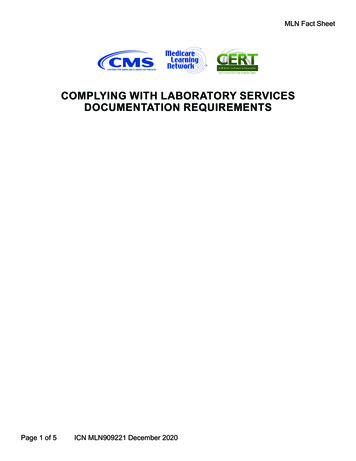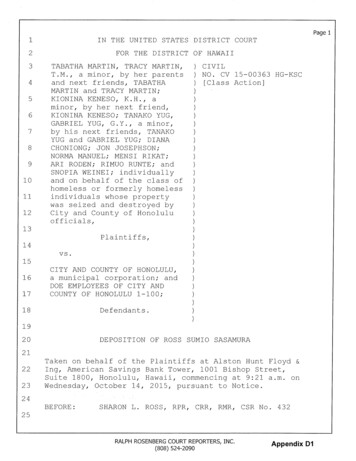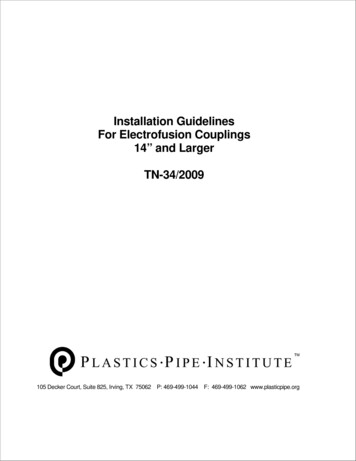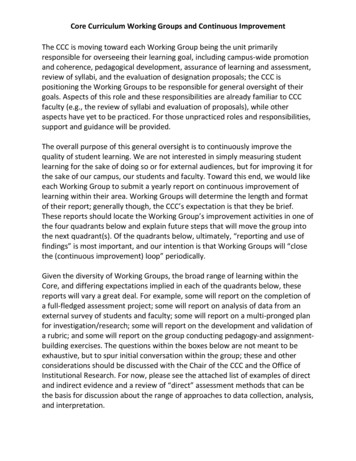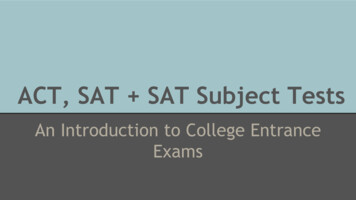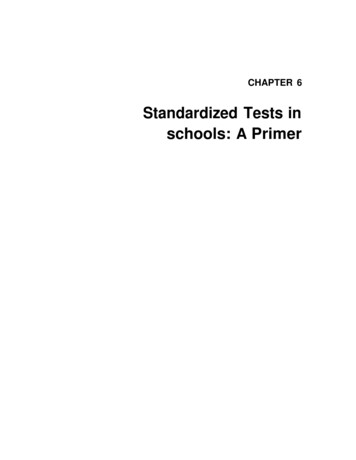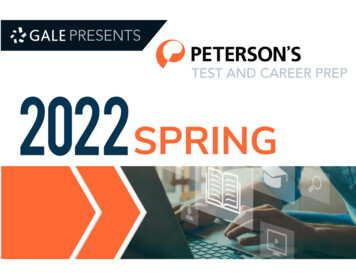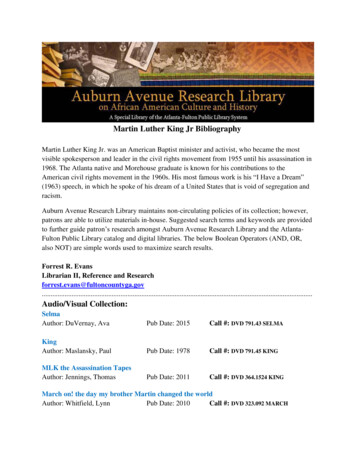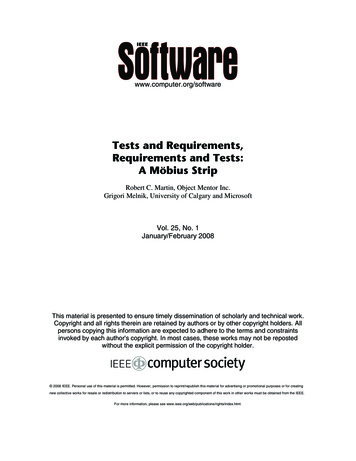
Transcription
www.computer.org/softwareTests and Requirements,Requirements and Tests:A Möbius StripRobert C. Martin, Object Mentor Inc.Grigori Melnik, University of Calgary and MicrosoftVol. 25, No. 1January/February 2008This material is presented to ensure timely dissemination of scholarly and technical work.Copyright and all rights therein are retained by authors or by other copyright holders. Allpersons copying this information are expected to adhere to the terms and constraintsinvoked by each author's copyright. In most cases, these works may not be repostedwithout the explicit permission of the copyright holder. 2008 IEEE. Personal use of this material is permitted. However, permission to reprint/republish this material for advertising or promotional purposes or for creatingnew collective works for resale or redistribution to servers or lists, or to reuse any copyrighted component of this work in other works must be obtained from the IEEE.For more information, please see www.ieee.org/web/publications/rights/index.html.
focus 2requirements and agilityTests and Requirements,Requirements and Tests:A Möbius StripRobert C. Martin, Object Mentor Inc.Grigori Melnik, University of Calgary and MicrosoftWriting acceptancetests earlyis a requirementsengineeringtechnique thatcan save time andmoney and helpbusinesses betterrespond to change.Surprisingly, to some people, one of the most effective ways of testing requirements is with test casesvery much like those for testing the completed system. —Donald C. Gause and Gerald M. Weinberghen Donald Gause and Gerald Weinberg wrote this statement,1 theywere asserting that writing tests is an effective way to test requirements’completeness and accuracy. They also suggest writing these tests whengathering, analyzing, and verifying requirements—long before those requirements are coded. They go on to say, “We can use the black box concept during requirements definition because the design solution is, at this stage, a truly black box. Whatcould be more opaque than a box that does not yet exist?”1 Clearly, they value early testWcases as a requirements-analysis technique.Testing expert Dorothy Graham agrees. Sherecommends performing test-design activities “assoon as there is something to design tests against—usually during the requirements analysis.”2 According to Graham, designing tests highlightswhat users really want the system to do. If software professionals design tests early and with users’ involvement, they can discover problems before building them into the system.The testing community has also promoted earlywriting of acceptance tests,3 but this remains atodds with much practice. Most development organizations don’t write acceptance tests. The first teststhey write are often manual scripts, written afterthe application starts executing. They base theseregression tests on the executing system’s behavioras opposed to the original requirements. Instead ofmanual tests, some organizations use record-and54IEEE SOFT WAREPublished by the IEEE Computer Societyplayback tools to automate their tests. These toolsrecord the tester’s strategic decisions by watchingthe tester operate the current system and remembering how the system responds. Later, the tool canrepeat the sequence and report any deviation. Although record-and-playback tests can be valuable,4they’re written far later than Gause, Weinberg, andGraham suggest, and their connection to the original requirements is indirect at best.We argue for early writing of acceptancetests as a requirements-engineering technique.We believe that concrete requirements blendwith acceptance tests in much the same way asthe two sides of a strip of paper become oneside in a Möbius strip (see figure 1). In otherwords, requirements and tests become indistinguishable, so you can specify system behaviorby writing tests and then verify that behaviorby executing the tests.0 74 0 -74 5 9 / 0 8 / 2 5 . 0 0 2 0 0 8 I E E E
REQUTest precisionRecord-and-playback might occur late, but is itreally appropriate to write tests as part of requirements definition? Yes, because writing tests is away of being relentlessly precise. In essence, a testis a question that has a concrete answer, whereasa requirement is generally more abstract. Considerthe following requirement: “The system shall acknowledge the number of tickets purchased.” Asfigure 2 shows, a test could more concretely statethis requirement.This simple table is written in the FIT style(Framework for Integrated Testing, http://fit.c2.com). It shows three different ticket purchases, alongwith the acknowledgment that the system shouldoutput. The table provides a level of detail that’shard to put into the less formal language of “shall”statements. We see not only the precise message thatacknowledges the purchase but also subtleties ingrammar and the length of the play names.David Parnas recognized the value of tabularspecification as early as 1977 when he was workingon the A-7 project for the US Naval Research Lab.In 1996, he wrote,Tabular notations are of great help in situations like this. One first determines the structure of the table, making sure that the headers cover all possible cases, then turns one’sattention to completing the individual entriesin the table. The task may extend over weeksor months; the use of the tabular format helpsto make sure that no cases get forgotten.5Indeed, as we examine figure 2, we can think ofmany additional headers, such as “Where will theplay be held?” or “What time is the showing?” Thetable is far more suggestive than the original“shall” statement.The equivalence hypothesisIf you look closely at figure 2, you’ll see thatit’s difficult to tell whether it’s a requirement ora test. Clearly, it specifies the system behaviorand could be viewed as a kind of Parnas-tablerequirement. On the other hand, you could imagine a tester using this table to verify system operation. Indeed, you might even imagine a simplesoftware engine that reads the table, operates thesystem, and turns a light red or green, depending on whether the system’s behavior matches thetable’s specification.This fuzziness between requirements and testssuggests an idea that we call the equivalence hypothesis: “As formality increases, tests and require-IREMTSETFigure 1. Writing requirements and testing are interrelated, much likethe two sides of a Möbius strip.Purchase tickets and check acknowledgmentPlayQuantity Acknowledgment?Phantom 2You have purchased 2 tickets to Phantom of the Opera.Wizard1You have purchased 1 ticket to The Wizard of Oz.Cats1The play ‘Cats’ is not currently playing in a theater.Figure 2. A FIT (Framework for Integrated Testing) tablefor purchasing tickets.ments become indistinguishable. At the limit, testsand requirements are equivalent.” In a practicalsense, this hypothesis describes how many softwaredevelopment teams behave—typically, the passingof acceptance tests, as opposed to an examinationof the requirements, is the final criterion for shipping a system.Any reasonable hypothesis should be falsifiable;otherwise, it’s little more than a feel-good statement. To falsify our equivalence hypothesis, youwould have to construct a requirement and a testthat diverge as the formality increases. In otherwords, as the system description becomes more precise, the requirement becomes less testable. This, itseems to us, is virtually reductio ad absurdum.A hypothesis should also be predictive. Ourequivalence hypothesis predicts that an informalsystem description won’t be testable. Or, rather,you can’t write unambiguous tests against an imprecise requirement. Consider the following requirement, written at a higher abstraction level:“The system shall acknowledge the number of tickets purchased.” How should the system present thisacknowledgement? As a green light? A verbal response? By mail? Also, when should it give it—immediately, or six months from now?Executable test-basedspecificationsIf our equivalence hypothesis is true, we shouldJanuary/February 2008 I E E E S O F T W A R E55
User: bob searches for play: Phantom where: Toronto when: July 2007Search ResultsplayThe Phantom of the OperaPhantom BandNo Face Phantomstatusavailableavailablesold outreject user: bob chooses play: Phantomassystem error: No such play. Try again.user: bob chooses play: The Phantom of the OperaPlay AvailabilitydatetimeJuly 15, 2007 2:00 pmJuly 15, 2007 8:00 pmJuly 16, 2007 8:00 pmvenuePantages theaterPantages theaterPantages theateruser: bob chooses showing at: 8:00 pm on: July 15, 2007Seating Section AvailabilityplaydateThe Phantom of the Opera July 15, 2007The Phantom of the Opera July 15, 2007The Phantom of the Opera July 15, 2007time8:00 pm8:00 pm8:00 pmseatingmain floorfirst balconysecond balconyuser: bob chooses seating: first balconyBenefits of narrativesand sufficient formalityDiscount Availabilitytypepricefull price 95.00student 80.00senior 80.00child 32.00Notice how close the test in figure 3 is to a normalnarrative or use case. If desired, a simple postprocessor or browser option could make the test lookeven more like a colloquial scenario. This closenessto human language means that stakeholders and developers can easily read these requirements and infer the same meaning from them. (A series of quasiexperiments and case studies support this.9)And yet, for all their readability, these tests havesufficient formality to allow an automatic engineto run them and validate that the system behavesas specified. In short, the human-readable requirements are also executable acceptance tests. For example, if our ticket-sales application miscalculatesthe price of a child’s ticket, FitNesse will display thetest results in figure 4.The red and green highlighting makes evaluating these test results easy. As Cem Kaner points out,ease of evaluation is “valuable for all tests, but is especially important for scenarios because they arecomplex.”10 After all, we don’t want bugs to be exposed by a test but not recognized by the engineering team.Another important benefit of concrete examplesuser: bob chooses discount: full price quantity: 2.Figure 3. A specificationscenario for a ticketsales system.56tables specify user interactions with the system, including both happy and sad paths.According to Ian Alexander and Neil Maiden,these “sequences of events in time are at the heartof our ability to construct meaning.”7 Furthermore,other researchers have recognized that “tables, unlike natural language, encode temporal sequencesunambiguously.”8 Taken as a whole, we see an entire workflow, including user actions and systemresponses. The result looks close enough to an ordinary story that people can understand it withoutinordinate effort. What’s more, specifiers can writeplain text stories and then maneuver those storiesinto tables.This ease of reading and authoring is criticalfor requirements engineering, because stakeholders who aren’t technologically savvy often performthe specification. Furthermore, requirements aremore credible and motivating if stakeholders writethem—or at least help write them.The notion that stakeholders can write testsdoesn’t imply that we should suddenly discard ouryears of testing experience in favor of customerwritten tests. On the contrary, although writingtests in a language that customers can read—andeven write—is valuable, testing professionals stillmust apply techniques such as boundary value analysis, path analysis, and state transition analysis.IEEE SOFT WAREbe able to specify system behavior using tests andthen verify that the system behaves as specified byexecuting those tests. The open source tool FitNesse(http://fitnesse.org) provides a collaboration platform to flesh out requirements written as tests in theFIT style.6 FitNesse also contains a test-running engine that can apply those tests to the system beingspecified. Here, we use this tool to specify a simpleticket-sales system.As you can see from the specification episodein figure 3, we use both declarative and proceduraltables. The declarative tables have column headersand rows that show a query result. The proceduralw w w. c o m p u t e r. o rg /s o f t w a re
Discount Availabilitytypepricefull price 95.00student 80.00senior 80.00 32.00 expectedchild 31.99 actualFigure 4. The test results FitNessedisplays in correct cases (full, senior, andstudent prices) and in one erroneous case(miscalculation of a child’s ticket price).and FIT-style specifications is that they help developers, managers, testers, and stakeholders avoid misunderstandings. They help the parties agree on business needs and terminology through the creationand enhancement of a ubiquitous language—that is,a well-documented (through tests) shared languagethat can express the necessary domain informationas a common medium of communication.11Automated spec autogenerated specWriting requirements as tests in the FIT styleshouldn’t be confused with some earlier approachesthat autogenerated test scripts from requirementspecifications, finite-state machines, activity diagrams, and so forth. These approaches weren’t verysuccessful in practice. According to Klaus Weidenhaupt and his colleagues, “the main problem wasthat the scenarios developed during requirementsengineering and system design were out of date atthe time the system was going to be tested.”12Also, don’t confuse FIT-style requirements testswith “operational specifications” that support formal reasoning (such as Gist, Statemate, or PAISley).These specifications are powerful, but they’re quitecryptic for an ordinary business person.When using the FIT style, the specification itselfis a test suite. The requirements and tests evolve withthe system. Indeed, in an environment where continuous integration and rigorous testing are practiced,13 a FIT-style requirements document wouldnever be out of sync with the application itself. Thisis because any disagreement between the requirements and the code would cause the build to fail!A more complex scenarioSoftware is hard. Most tools break when youwant to do something a bit more complicated thantheir designers expected—that is, when you mostneed them. Can we use the FIT specification style insituations that are more complex than simple interaction scenarios?time is now 2006/10/03 10:24:00 amuser: bob chooses showing at: 8:00 pm on: July 15, 2007Seating Section AvailabilityplaydateThe Phantom of the Opera July 15, 2007The Phantom of the Opera July 15, 2007The Phantom of the Opera July 15, 2007time8:00 pm8:00 pm8:00 pmseatingquantity availablemain floor10first balcony5second balcony 2time is now 2006/10/03 10:24:10 amuser:greg chooses showing at: 8:00 pm on: July 15, 2007Seating Section AvailabilityplaydateThe Phantom of the Opera July 15, 2007The Phantom of the Opera July 15, 2007The Phantom of the Opera July 15, 2007time8:00 pm8:00 pm8:00 pmseatingquantity availablemain floor105first balconysecond balcony 2time is now 2006/10/03 10:24:15 amensureuser: greg buys: 10 seating: main floor with credit card: 331234176273Purchase Acknowledgmentplayseatingquantity total charge? acknowledgment?The Phantom of Main floor 10 950.00You have purchased 10 ticketsthe Operato The Phantom of the Opera.time is now 2006/10/03 10:24:20 amrejectuser: bob buys: 1 seating: main floor with credit card: 250192030292Purchase Acknowledgmentplayseatingquantity total charge? acknowledgment?The Phantom of main floor 0*NO CHARGE* Sorry, all main floor ticketsthe Operaare sold out.Consider the specification of a typical concurrency issue in figure 5. When we view this specification as a message-sequence chart (see figure 6), wesee that this is a classic race condition. Bob took histime selecting his seat, while Greg jumped in andgot all the remaining main floor tickets.Notice how these tests treat time as somethingthat can be controlled. Indeed, time is just anothersystem input that impacts the system state. If, as figure 5 shows, our tests can specify the flow of time,then we can describe concurrency issues and specifyhow the system with multiple synchronous stimuliand responses should behave.Specifying and testing performance is conceptually no more difficult than the concurrency test wepresented. The amount of time an operation takes ismerely another system output, which we can specifyand test just like any other output. It wouldn’t bedifficult to make the test shown in figure 7 execute.Figure 5. Thespecification of a typicalconcurrency issue.January/February 2008 I E E E S O F T W A R E57
BobReservation systemGregShow seats for Phantom, 8 pm, 7/1510:24:00Main floor: 10First balcony: 5Second balcony: 2Show seats for Phantom, 8 pm, 7/1510:24:10Main floor: 10First balcony: 5Second balcony: 210:24:15Buy 10 main floorAcknowledgmentBuy 1 main floor10:24:20Sold outFigure 6. The specification from figure 5, shown as a message-sequence chart.ensure transaction: choose showing executes: 1,000 times in less than: 5 secondsFigure 7. A sampletest that would beeasy to execute.Clearly, getting these specifications to execute astests requires some behind-the-scenes magic. What’sremarkable is the comparatively tiny amount of effort required to cast that magic spell. The glue codebehind the scenes is small, tightly encapsulated,highly reusable, and very easy to write.Potential business impactIf our equivalence hypothesis is true, and software professionals write their requirements in theform of acceptance tests, this could cut a lot oftime and money from the project’s test planningphase. The concrete nature of the test-based specifications could reduce the number of pointless features and code, making the project more agile.Furthermore, the development team would be ableto handle requirements changes more adequatelyand efficiently.In this article, we purposely avoided describing the detailed syntax of FIT to demonstratethat knowledge of that syntax isn’t required toread and understand the tests as requirements. Thiscould lead you to believe that there is no syntax and58IEEE SOFT WAREw w w. c o m p u t e r. o rg /s o f t w a rethat the tests are simply ad hoc conversions of narratives to tables. In fact, the syntax is sufficientlyformal for a computer program to interpret and execute unambiguously.Requirements written in the FIT style are alsotests. They form a Möbius strip that appears tohave two sides but, on careful inspection, has onlyone. The result is that the requirements becometangible. There can be no ambiguity about a requirement if that requirement can turn a light redor green.References1. D. Gause and G. Weinberg, Exploring Requirements,Dorset House, 1989, p. 249.2. D. Graham, “Requirements and Testing: SevenMissing-Link Myths,” IEEE Software, vol. 19, no. 5,2002, pp. 15–17.3. B. Hetzel, The Complete Guide to Software Testing,QED Information Sciences, 1983.4. G. Meszaros, “Agile Regression Testing Using Record& Playback,” Companion of the 18th Ann. ACM S IG PLAN Conf. Object-Oriented Programming, Systems,Languages, and Applications (OOPSLA 03), ACM Press,2003, pp. 353–360.5. R. Janicki, D. Parnas, and J. Zucker, Tabular Representations in Relational Documents, Communications Research Laboratory, McMaster University, 1995, p. 5.6. R. Mugridge and W. Cunningham, Fit for DevelopingSoftware, Prentice Hall, 2005.7. I. Alexander and N. Maiden, Scenarios, Stories, Use
8.9.10.11.12.13.Cases through the Systems Development Life-Cycle,John Wiley & Sons, 2004, p. 5.C. Potts, K. Takahashi, and A. Antón, “Inquiry-BasedRequirements Analysis,” IEEE Software, vol. 11, no. 2,1994, pp. 21–32.G. Melnik, F. Maurer, and M. Chiasson, “ExecutableAcceptance Tests for Communicating Business Requirements: Customer Perspective,” Proc. Agile 2006 Conf.,IEEE CS Press, 2006, pp. 35–46.C. Kaner, “On Scenario Testing,” Software Testing andQuality Eng. Magazine, Sept./Oct. 2003, pp. 16–22.E. Evans, Domain-Driven Design: Tackling Complexityin the Heart of Software, Addison-Wesley, 2004, p. 376.K. Weidenhaupt et al., “Scenarios in System Development: Current Practice,” IEEE Software, vol. 15,no. 2, 1998, pp. 34–45.M. Fowler, “Continuous Integration,” n.html, May 2006.About the AuthorsRobert C. Martin (Uncle Bob) is founder and president of Object Mentor. His researchinterests are agile programming, extreme programming, UML, object-oriented programming, and C programming. He has authored many books, including Designing ObjectOriented C Applications Using the Booch Method (Prentice Hall, 1995), Agile SoftwareDevelopment: Principles, Patterns, and Practices (Prentice Hall, 2002), and UML for JavaProgrammers (Prentice Hall, 2003). He served three years as the editor in chief of the C Report, and he served as a founder and first chairman of the Agile Alliance. Contact him atunclebob@objectmentor.com.Grigori Melnik is a senior product planner in the patterns and practices group at Mi-crosoft. Prior to that (and when this article was written), he was a researcher and facultymember at the University of Calgary. His research areas include agile methods, empiricalsoftware engineering, executable acceptance-test-driven development, and domain-drivendesign. He served as a guest editor of the IEEE Software special issue on Test-Driven Development and is program chair of the Agile 2008 World Conference. Contact him at grigori.melnik@microsoft.com.For more information on this or any other computing topic, please visit ourDigital Library at www.computer.org/csdl.A D V E R T I S E R I N D E X J A N U A R Y/ F E B R U A R Y 2 0 0 8Advertiser/ProductPage NumberClassifi ed Advertising49East Carolina University9ESRI12Gannon University7John Wiley & Sons, Inc.Cover 2SD West 2008Cover 3Seapine Software, Inc.Cover 4Advertising PersonnelMarion DelaneySandy BrownIEEE Media,IEEE Computer Society,Advertising DirectorBusiness DevelopmentPhone: 1 415 863 4717ManagerEmail: md.ieeemedia@ieee.orgPhone: 1 714 821 8380Fax: 1 714 821 4010Marian AndersonEmail: sb.ieeemedia@ieee.orgAdvertising CoordinatorPhone: 1 714 821 8380Fax: 1 714 821 4010Email: manderson@computer.org*Boldface denotes advertisements in this issue.Advertising Sales RepresentativesMid Atlantic (product/recruitment)Dawn BeckerPhone: 1 732 772 0160Fax: 1 732 772 0164Email: db.ieeemedia@ieee.orgNew England (product)Jody EstabrookPhone: 1 978 244 0192Fax: 1 978 244 0103Email: je.ieeemedia@ieee.orgNew England (recruitment)John RestchackPhone: 1 212 419 7578Fax: 1 212 419 7589Email: j.restchack@ieee.orgConnecticut (product)Stan GreenfieldPhone: 1 203 938 2418Fax: 1 203 938 3211Email: greenco@optonline.netSouthwest (product)Steve LoerchPhone: 1 847 498 4520Fax: 1 847 498 5911Email: steve@didierandbroderick.comNorthwest (product)Lori KehoePhone: 1 650 458 3051Fax: 1 650 458 3052Email: l.kehoe@ieee.orgSouthern CA (product)Marshall RubinPhone: 1 818 888 2407Fax: 1 818 888 4907Email: mr.ieeemedia@ieee.orgNorthwest/Southern CA(recruitment)Tim MattesonPhone: 1 310 836 4064Fax: 1 310 836 4067Email: tm.ieeemedia@ieee.orgMidwest (product)Dave JonesPhone: 1 708 442 5633Fax: 1 708 442 7620Email: dj.ieeemedia@ieee.orgWill HamiltonPhone: 1 269 381 2156Fax: 1 269 381 2556Email: wh.ieeemedia@ieee.orgJoe DiNardoPhone: 1 440 248 2456Fax: 1 440 248 2594Email: jd.ieeemedia@ieee.orgSoutheast (recruitment)Thomas M. FlynnPhone: 1 770 645 2944Fax: 1 770 993 4423Email: flynntom@mindspring.comSoutheast (product)Bill HollandPhone: 1 770 435 6549Fax: 1 770 435 0243Email: hollandwfh@yahoo.comJapan (recruitment)Tim MattesonPhone: 1 310 836 4064Fax: 1 310 836 4067Email: tm.ieeemedia@ieee.orgEurope (product)Hilary TurnbullPhone: 44 1875 825700Fax: 44 1875 825701Email: impress@impressmedia.comMidwest/Southwest (recruitment)Darcy GiovingoPhone: 1 847 498-4520Fax: 1 847 498-5911Email: dg.ieeemedia@ieee.orgJanuary/February 2008 I E E E S O F T W A R E59
Surprisingly, to some people, one of the most effective ways of testing requirements is with test cases very much like those for testing the completed system. —Donald C. Gause and Gerald M. Weinberg W hen Donald Gause and Gerald Weinberg wrote this statement,1 they were asserting that writing tests is an effective way to test requirements'

